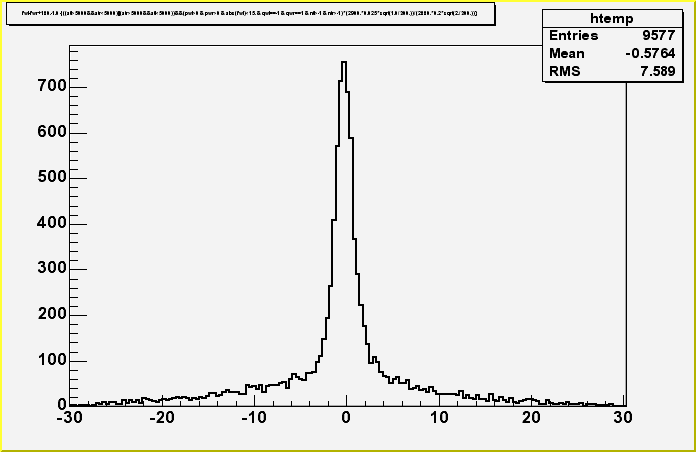Hello, I just wanted to show you new results about normalization and total
data rate (elastic events) for most recent ep elastic data (last week).
This is the first BLAST comparison of reconstructed data (newton fitter)
taken with the ABS (single spin state, warm cell) to known cross sections.
The results are not polished, but they still allow some considerations.
The simulation (red) is a result from dgen (chi) with no radiative tail
and unpolarized cross section.
The data (black) is cut on
1) netwon (means: all variables reconstructed)
2) scintillator adc (adc <5000 for tof 0-7, > 5000 for tof 8-15)
3) +- 2.5 deg around the reconstructed coplanarity peak (see 3,4th
attachments for the data coplanarity peak)
4) an additional cut on the out-of-plane acceptance (+- 15 deg)
was necessary for a meaningful comparison with blastmc
The data is normalized according to the scaler integrated charge (2.9 kC)
and a nominal ABS gas flow intensity of 1.1xE16 At/s (0.025 SCCM) as
estimated from the ligit pressure.
_ The comparison between data and montecarlo is quite good as far as scale
and integrated yield. Also note that we have applied no correction for
the fraction of reconstructed data or of atomic flow actually captured by
the cell. Both fractions seem to be very high.
_ The data is still reconstructed poorly, meaning 5 % in momentum, ca 1
deg in angle. There is of course hope to improve this in the long run with
new calibrations, better electronic map, better fast fit. Note that the
(for a comparable coinc window) fraction of reconstructed events is
significantly higher than for runs 30xx of last year (a factor of ca. 7)
_ The montecarlo clearly has some issues in phi electron (not symmetric).
Note that montecarlo events are reconstructed similarly to real data
(but the resolution there is much better)
_ There is a dip in the electron angle. This is expected to be due to a small
gap in the tofs. This is also the region where the tof orientation w.r.t beam
changes.
- To get this plot run
> root compare.C 303-306 308-309 311-317 323-328 349-359 362-368 -c padc -c coplaw_tight
This data sample corresponds to 2.9 kc, equivalent to about 20 hrs with
beamgate_on at 40 mA. The total number of selected elastic events is
5500, accumulated over 36 runs for a calendar time of less than 30 hrs.
The efficiency of data taking (when continuosly taking data) is also
satisfactory. Note the daq is 10 % dead typically. Over these runs the
beam was injected at 80-100 mA.
The same 5500 events (runs 303-306 308-309 311-317 323-328 349-359
362-368) shown here where used in the asymmetry determination. However, to
check systematics in the asymmetry they were divided the 4 target/beam
spin states. Effectively this doubles the error bars.
The BLAST rate, although small, is consistent with montecarloexpectations.
With an expected factor sqrt(3) from the cold target, next week we may
expect more than 20k good events in a 3 days run, with 48 hrs of actual
data taking (beamgate on). This would be a factor of 2 improvement in the
error bar.
Please note that good evelastic events are 1 % of the total daq rate,
although at this moment the main drawback is a slower reconstruction.
-- tancredi (and chi)
________________________________________________________________________________
Tancredi Botto, phone: +1-617-253-9204 mobile: +1-978-490-4124
research scientist MIT/Bates, 21 Manning Av Middleton MA, 01949
^^^^^^^^^^^^^^^^^^^^^^^^^^^^^^^^^^^^^^^^^^^^^^^^^^^^^^^^^^^^^^^^^^^^^^^^^^^^^^^^


This archive was generated by hypermail 2.1.2 : Mon Feb 24 2014 - 14:07:29 EST